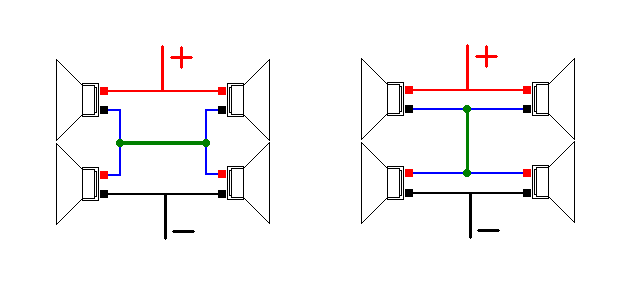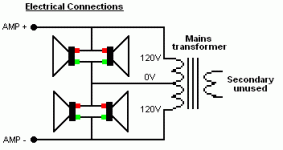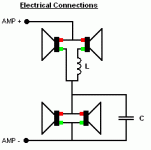This is a Parallel-Serie connection, good for keep the same impedance, sound quality not as good as a pure parallel etc...
This green line in the middle addition the two sets impedances. You could do this connection for 4 drivers of 8 ohms etc
Please tell me where the error is. I am comparing mine and your image side by side. Please tell me if I made a mistake in describing the connections in each photo.
An externally hosted image should be here but it was not working when we last tested it.
1. In my image, first and second drivers' terminals are connected positive-positive and negative-negative. Parallel connection. In your image, it's the same.
2. In my image, third and fourth drivers' terminals are connected positive-positive and negative-negative. Parallel connection. In your image, it's the same.
3. In my image, there is a connection from the negative terminal of the second driver to the positive terminal of the third driver. Series connection between the two arrays. In your image, it's the same. Except that in my image it is blue and in your image it is green. But does the color of the interconnect make any difference in the real world connection properties? As much as I know, No.
4. In my image, two wires are crossing over, however, are not joined in the cross-over point. In your image, no wire is crossing over. But again, does this mean anything in the real world connection properties? I think No.
So, I ask you to carefully look at my image again and tell me where the mistake resides.
Thanks.
Last edited:
Hi Shaan
I vote for the one on the left (repeated in your post #9).
In theory both schematics give identical results but in real life the drivers will not be identical.
The main issue is if you take two drivers with different resonant frequencies and connect them in series, there will be a small frequency range where the cones tend to move out of phase with each other - high driver excursion without matching output. This is a accompanied by a big peak in impedance.
Connecting the 2 in parallel forces them to work together in a more coordinated fashion and gives much better damped impedance hump.
I'd prefer a series connection of 2 well damped parallel-connected pairs to a parallel connection of two badly-behaved series-connected pairs.
Hope all of the above makes some sense - I'm up to my eyeballs in painkillers right now (and they're not f***ing working either 😕😡) - so struggling to be coherent.
Cheers - Godfrey
p.s. half agree with richie00boy about safety, but I'm assuming you're not planning to blow them one at a time anyway.
Thanks! Thanks a lot for the info!
Excuse me, I must say I have no conditions to say which is the best in this case, cause I have no large experience in fullranges, since I built just two FR projects. I like use the short wiring possible.Or maybe the third pattern where they alternate?
😕
My guess is it won't make much difference anyway, but may be worth thinking about.
But a near floor OB woofer or FR have more bass output, than a hi position driver, If the driver is not OB, but a boxed, the hi positions drivers have conditions to give lots of bass too, as they may be stuffed inside the box.
Gustavo
Hmm ....
Maybe we can agree on this wiring diagram - redrawn with no wires crossing over?
And now for something different to argue about - the physical layout:
Each driver will be affected by how close to the floor it is, so maybe it's bad for one parallel pair to be close to the floor, and the other pair at the top (see "bad" example).
From that point of view, the "good" example would be better - with the top and bottom drivers in parallel and the middle two in parallel.
Or maybe the third pattern where they alternate?
😕
My guess is it won't make much difference anyway, but may be worth thinking about.
I will be on this after I settle the current problem. Thanks for pointing out.
I ask excuses, the both images are the same electrically, the connection is the same. Was my fault, sorry.
Just thinking, the series connection provides better transient response but isn't very popular for having bad HF response. Parallel is quite popular for its focus on forcing all the drivers to work together/in phase and overall better sound but draws at least double the power of a single driver.
From an "audiophile" perspective I think "overall better sound" is preferable to "better transients". As I play mostly classical pieces I think the parallel connection is "good" for me and series connection is "not good". 🙂
random thought...
Matter-1:- In the series-parallel mode two arrays of "not good" series connected speakers are "pulled up" towards a good one by connecting the arrays in parallel.
Matter-2:- In the parallel-series mode two arrays of "good" parallel connected speakers are "pulled down" towards a not good one by connecting the arrays in series.
Mental peace:- As a listener, I think the idea of pulling down two "good" things together towards bad is a better idea than pulling up two bad things towards good.
How? Well, again, random thought, in the Series-Parallel there are two series and one parallel connection; two bad and one good. But in the Parallel-Series there are two good and one bad. So, I think I will go for the Parallel-Series connection. After all, I "know" that inside the box there are two good things and only one bad.
Feel Good Matter.
From an "audiophile" perspective I think "overall better sound" is preferable to "better transients". As I play mostly classical pieces I think the parallel connection is "good" for me and series connection is "not good". 🙂
random thought...
Matter-1:- In the series-parallel mode two arrays of "not good" series connected speakers are "pulled up" towards a good one by connecting the arrays in parallel.
Matter-2:- In the parallel-series mode two arrays of "good" parallel connected speakers are "pulled down" towards a not good one by connecting the arrays in series.
Mental peace:- As a listener, I think the idea of pulling down two "good" things together towards bad is a better idea than pulling up two bad things towards good.
How? Well, again, random thought, in the Series-Parallel there are two series and one parallel connection; two bad and one good. But in the Parallel-Series there are two good and one bad. So, I think I will go for the Parallel-Series connection. After all, I "know" that inside the box there are two good things and only one bad.
Feel Good Matter.
Quote: "two good things and only one bad"
If you can live with a transformer, it can be all good.🙂
Nothing fancy - just an ordinary, cheap mains transformer.
Linearity should be really good. Since they're designed for 240V @ 50Hz, you won't be getting them anywhere near saturation.
If the DC resistance is too low, you could add a small resistor to each end of the primary, but probably not needed, especially if the amplifier is transformer or capacitor coupled at the output.
Actually, if the amp does have a capacitor-coupled output, transformers in the speakers could help with switch-on thump too.
You mentioned SE class A. Any details? (sorry for the OT)
If you can live with a transformer, it can be all good.🙂
Nothing fancy - just an ordinary, cheap mains transformer.
Linearity should be really good. Since they're designed for 240V @ 50Hz, you won't be getting them anywhere near saturation.
If the DC resistance is too low, you could add a small resistor to each end of the primary, but probably not needed, especially if the amplifier is transformer or capacitor coupled at the output.
Actually, if the amp does have a capacitor-coupled output, transformers in the speakers could help with switch-on thump too.
You mentioned SE class A. Any details? (sorry for the OT)
Attachments
You seem to have neglected the altering of damping factor, lack of high frequency response, bulk, losses, and other distortions introduced by a (mains) transformer used in that way.
Quote: "two good things and only one bad"
If you can live with a transformer, it can be all good.🙂
Nothing fancy - just an ordinary, cheap mains transformer.
Linearity should be really good. Since they're designed for 240V @ 50Hz, you won't be getting them anywhere near saturation.
If the DC resistance is too low, you could add a small resistor to each end of the primary, but probably not needed, especially if the amplifier is transformer or capacitor coupled at the output.
Actually, if the amp does have a capacitor-coupled output, transformers in the speakers could help with switch-on thump too.
You mentioned SE class A. Any details? (sorry for the OT)
I'm using a 20watt MOSFET power follower driven by DoZ preamp as my amp. It's class-a and needs no transformer at the output. 😎
🙂 Sorry I cannot live with a transformer at the output in any way. I don't wish it to be all good, little imperfection will be no problem as I'm no perfect.
.
Last edited:
Nope, no neglect. The transformer's purpose is only to help ensure the input voltage is divided equally between the top and bottom halves at low frequencies.
At high frequencies, where the leakage inductance becomes significant, that will effectively remove the transformer from the circuit, which is fine - it's only there to help with low-frequency symmetry.
Losses should be minimal, and will only present a slight extra load in parallel with the drivers.
It doesn't add anything in series with the speakers, so there's no effect on damping, frequency response etc.
At high frequencies, where the leakage inductance becomes significant, that will effectively remove the transformer from the circuit, which is fine - it's only there to help with low-frequency symmetry.
Losses should be minimal, and will only present a slight extra load in parallel with the drivers.
It doesn't add anything in series with the speakers, so there's no effect on damping, frequency response etc.
One thing I noticed is that the sound quality does degrade in the parallel-series/series-parallel connection's output compared to the output of a single driver. But it is said that I must sacrifice some quality to get all four drivers working in arrays. There are four coils, nobody can disagree, quality is expected to be less than a single coil's performance. Well, making that sacrifice I feel better, as the speakers won't be blown if I turn the volume up. 🙂
MOSFET follower DC coupled to the speaker?
I was thinking output transformer for a valve amp and maybe a capacitor for SE SS.
Sorry, my previous post was a response to richie00boy.
I was thinking output transformer for a valve amp and maybe a capacitor for SE SS.
Sorry, my previous post was a response to richie00boy.
At high frequencies, where the leakage inductance becomes significant, that will effectively remove the transformer from the circuit, which is fine - it's only there to help with low-frequency symmetry.
The series connection makes the HFs worse. That is the only "bad" thing i mentioned earlier. If the transformer is electrically not present in the HF range then how can it minimize the "bad"? 😕
MOSFET follower DC coupled to the speaker?
I was thinking output transformer for a valve amp and maybe a capacitor for SE SS.
Sorry, my previous post was a response to richie00boy.
Just adding little more info, It's Cap coupled SE class-a. 😀
Preamp

Follower


Follower

Last edited:
Sorry, I was thinking LF "bad". Just went back and re-read your posts now.The series connection makes the HFs worse. That is the only "bad" thing i mentioned earlier. If the transformer is electrically not present in the HF range then how can it minimize the "bad"? 😕
I'm surprised series connection improves transients while degrading HFs.
No surprise a single driver sounds better though. Have you considered a crossover to transition from four drivers at LF to a single driver at HF?
Could be nice with a single driver handling the upper mid / treble and the other three just helping with excursion and power handling lower down.
It's more work for the one handling the HF on it's own, but shouldn't be devastating if you don't cross too low. Most of the energy in music is in the bass and low mid, with less power higher up. That's why tweeters "suitable for systems up to 100W" can typically only handle about 10 or 20 Watts in the treble without damage.
Attachments
Sorry, I was thinking LF "bad". Just went back and re-read your posts now.
I'm surprised series connection improves transients while degrading HFs.
No surprise a single driver sounds better though. Have you considered a crossover to transition from four drivers at LF to a single driver at HF?
Could be nice with a single driver handling the upper mid / treble and the other three just helping with excursion and power handling lower down.
It's more work for the one handling the HF on it's own, but shouldn't be devastating if you don't cross too low. Most of the energy in music is in the bass and low mid, with less power higher up. That's why tweeters "suitable for systems up to 100W" can typically only handle about 10 or 20 Watts in the treble without damage.
Thanks for the info. I am considering no components in the speaker enclosure except the drivers. No passive crossover.
The amps are fed the high-pass output of a 4th order LR crossover with a crossover frequency of 155hz. There will be no tweeter. Just what comes from the FR drivers along is enough.
.
I am considering no components in the speaker enclosure except the drivers.
... like it says in your sig. 😀
... like it says in your sig. 😀
LOL Once I even thought of placing a voice coil and magnet on my eardrums and micro-amps placed within them. Even then it could not satisfy me! As the signal must have a wire to transfer! but wait, what about wireless transfer? Well, that's still some "thing". I don't like that too!
Well, the box will contain some straight(or not so straight) wires.
In the end, there is only Despair. LOLOL
Last edited:
So, I was connecting the speakers in the Parallel-Series way. But I got one more problem while making the connections. It's regarding the ONE piece of wire that lies between the two arrays(shown in dark green line). It seems I can connect that thing in two ways, both complies with the parallel-series config. Which should I choose? Which config is better?

- Status
- Not open for further replies.
- Home
- Loudspeakers
- Full Range
- Series-Parallel Or Parallel-Series

